Manombo Lampeye (Pantanodon sp.)
The Manombo Lampeye, which does not yet have a scientific name, is only known from a single specimen collected from a small swamp area in the Manombo Special Reserve in the Atsimo-Atsinanana region of southeastern Madagascar, where the species inhabited an area of only approx. 10 km² inhabited.
This swamp area has apparently now been converted into rice fields and the fish species, which was last seen in 1997 (?), is therefore probably extinct.
*********************
edited: 07.01.2012
Tag Archives: Madagascar
Breonia richardsonii Razafim.
Richardson’s Breonia (Breonia richardsonii)
This species has been described in 2002 on the basis of herbarium material that had been collected in 1965 from a lowland forest in the Maroantsetra District in the Toamasina Province of Madagascar.
“This species is very different from other species of Breonia because of its tubular, ap- pressed inflorescence bracts with 3 to 4 broadly triangular lobes and post-anthesis fusion of adjacent ovaries.” [1]
The species has not been recorded since the type material was collected and is either extremely rare or even already extinct.
***
The photo below shows a related species, Perrier’s Breonia (Breonia perrieri Homolle), which is likewise endemic to Madagscar.
*********************
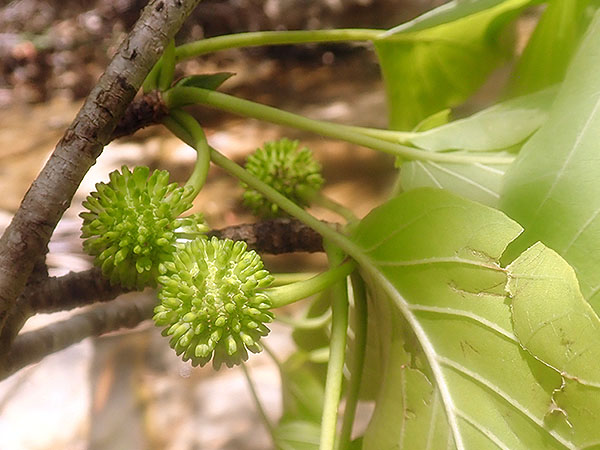
Photo: merveille
https://www.inaturalist.org/people/bmerveille
http://creativecommons.org/licenses/by-nc/4.0/
*********************
References:
[1] Sylvain G. Razafimandimbison: A systematical revision of Breonia (Rubiaceae-Naucleeae). annals of the Missouri Botanical Garden 89(1): 1-37. 2002
*********************
edited: 26.02.2024
Eulophia grandidieri H. Perrier
Grandidier’s Harlequin Orchid (Eulophia grandidieri)
This terrestrial species is known exclusively from its type which had been collected in 1901 near the city of Toamasina in eastern Madagascar, a region that is now almost completely deforested.
The species is very likely extinct.
*********************
edited: 11.02.2024
Vernonia ampandrandavensis Humbert
Ampandrandava Vernonia (Vernonia ampandrandavensis)
This little tree is endemic to a region named Ampandrandava in the Toliara Province of southern Madagascar.
The species was last seen in 1944 and is considered likely extinct.
***
The photo below shows a related species, the Flat-scaled Vernonia (Vernonia platylepis Drake)
*********************
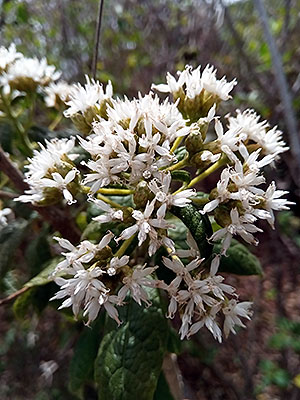
Photo: Landy Rita
https://www.inaturalist.org/people/landyrita1
https://creativecommons.org/licenses/by-nc/4.0/
*********************
edited: 05.01.2024
Andriana hancocki (Bruner)
The Big Royal Pygmy Grasshopper was described in 1910; the species was restricted to the lowland forests near the city of Fenoarivo Atsinanana at eastern shore of Madagascar.
The species has not been seen since 1971 and, due to the loss of forests in the region, is likely extinct.
*********************
edited: 23.08.2022
Angraecum serpens (H. Perrier) Bosser
The Creeping Angraecum was described in 1970; it was apparently found in a forested locality near the village of Fanovana in the Analanjirofo region at the eastern coast of Madagascar.
This species appears to be extinct.
*********************
edited: 14.11.2021
Babakotia radofilai Godfrey et al.
Radofilao’s Sloth Lemur was described in 1990 based on subfossil remains that were found in some limestone caves along the northern coast of Madagascar, and which could be dated to ages of about 3100 to 2800 BCE..
*********************
edited: 16.05.2022
Bulbophyllum tampoketsense H. Perrier
This species was described in 1937; it originates from central Madagascar.
The name of this species appears in lists of extinct plants and is thus mentioned here briefly until I have more information about it.
*********************
edited: 23.04.2022
Vorombe titan (Andrews)
The Giant Elephant Bird was originally described in 1894, however, the whole elephant bird family was in urgent need of a proper revision, which indeed took place in 2018 and which lead to a reduction of the number of species and the description of a completely new genus for the largest of the species. [1]
The species must have reached a size of 3 m and must have weighted up to 730 kg, making it the heaviest known bird, dead or alive.
The Giant Elephant Bird died out shortly after the arrival of humans on the island of Madagascar, most likely due to habitat destruction and overhunting.
*********************
References:
[1] James P. Hansford; Samuel T. Turvey: Unexpected diversity within the extinct elephant birds (Aves: Aepyornithidae) and a new identity for the world’s largest bird. Royal Society Open Science 5(9): 1-28. 2018
*********************
edited: 22.01.2022
Cynorkis rolfei Hochr.
Rolfe’s Cynorkis Orchid (Cynorkis rolfei)
Rolfe’s Cynorkis Orchid was a little terrestrial orchid species endemic to Madagascar, it was described in 1908.
The species is apparently only known from the type and might now be extinct.
*********************
edited: 12.11.2020
Brachypteracias langrandi Goodman
Ampoza Ground Roller (Brachypteracias langrandi)
The Ampoza Ground Roller was described in 2000 on the basis of a single subfossil humerus that had already been discovered in 1929 at Ampoza in central south-western Madagascar.
The locality lies within the dry deciduous forest region and is obviously not inhabited by any species of the Brachypteraciidae family, which, except for one species, prefer humid forests and rainforests.
The species disappeared sometimes after the coloniuation by human settlers due to human-induced climate changes that led to the desertification of many of Madagascar’s regions.
***
The depiction below shows the sole still living member of the genus, the Short-legged Ground Roller (Brachypteracias leptosomus (Lesson)).
*********************

Depiction from: ‘Alfred Grandidier: Histoire Physique, Naturelle et Politique de Madagascar. Paris: à l’Imprimerie Nationale 1836-1921’
(public domain)
*********************
References:
[1] Steven M. Goodman: A description of a new species of Brachypteracias (Family Brachypteraciidae) from the Holocene of Madagascar. Ostrich. 71(1-2): 318-322. 2000
*********************
edited: 28.02.2024
Proplatycnemis longiventris (Schmidt)
Long-bellied White-legged Damselfly (Proplatycnemis longiventris)
This species is known only by its type which had been collected in 1933 or -34 from the vicinity of the city of Ambanja at the Sambirano River in north-western Madagascar.
The status of this species is currently unknown, but it could potentially be extinct.
***
syn. Platycnemis longiventris Schmidt
*********************
edited: 24.08.2022
Palaeopropithecus ingens G. Grandider
Large Sloth Lemur (Palaeopropithecus ingens)
This species was described in 1899 based on subfossil remains that had been found in Madagascar.
The Large Sloth Lemur was apparently restricted to the southern part of Magadascar
***
The species is known to have survived into the 17th century, bones from a remote cave in the interiror of southern Madagascar could be dated to an age of about 1285 to 1625 AD. The species is mentioned in Malagasy folklore accounts as the tratratratra or tretretretre and was also mentioned by Étienne de Flacourt, who was the french governor of Madagascar from 1648 to 1655.:
“The Tretretretre, or Tratratratra, is an animal as large as a two-year- old calf, and which has a round head and a man’s face; the fore-feet like those of a Monkey, and the hind ones also. It has curled hair, a short tail, and ears like those of a man. … It has been seen near Lake Lipomani, in the vicinity of which is ils lair. It is a very solitary animal, which the people of the country hold in great fear and run away from, as it also does from them.” [1]
I have not yet read the original, which is in French, and there are several translations, which sometimes mention a Lake Lipomani or a Lipomani Lagoon, which I could not detect yet.
*********************
References:
[1] Étienne de Flacourt: Histoire de la grande Isle Madagascar composée par le Sieur de Flacourt, Directeur Général de la Compagnie Françoise de l’Orient, & Commandant pour sa Majesté dans ladite Isle & és Isles adjacentes. Avec une Relation de ce qui s’est passé és année 1655. 1656. & 1657. non encore veuë par la premiere Impression, Paris: Gervais Clovzier 1661
[2] David A. Burney; Ramilisonina: The Kilopilopitsofy, Kidoky, and Bokyboky: Accounts of strange animals from Belo-sur-mer, Madagascar, and the megafaunal “extinction window”. American Anthropologist 100(4): 957-966. 1999
*********************
edited: 01.10.2020
Stephanoaetus mahery Goodman
Malagasy Crowned Eagle (Stephanoaetus mahery)
The Malagasy Crowned Eagle was described in 1994 based on subfossil remains found on the island of Madagascar.
The species was quite similar to the African Crowned Eagle (Stephanoaetus coronatus (L.)), one of the largest eagles in the world, but was probably even slightly larger.
The eagle inhabited the forested areas of Madagascar until around 1500 AD. And was wiped out by humans.
***
Like its African cousin this species was able to hunt for the middle-sized to large primate species, the lemures, and apparently was one of the apex predators on the island; in fact the recent lemures still show a distinct raptor avoidance behavior that dates back to the time when their biggest enemy was still alive.
*********************

Photo: Bernard Dupont
(under creative commons license (2.0))
https://creativecommons.org/licenses/by-sa/2.0/
*********************
edited: 25.05.2021
Sartidia perrieri (A. Camus) Bourreil
Perrier’s Sartidia Grass (Sartidia perrieri)
This grass species is known exclusively from the type material that was found in 1914 growing on sandstone rocks in a woodland near Antsirabe at an elevation of about 1900 m; it appears to have already been very rare at that time.
The species was never recorded again and is now considered most likely extinct.
***
syn. Aristida perrieri A. Camus
*********************
References:
[1] Maria S. Vorontsova; Thomas Haevermans; Agathe Haevermans; Jacqueline Razanatsoa; Marjorie R. Lundgren; Guillaume Besnard: The Genus Sartidia (Poaceae: Aristidoideae) in Madagascar. Systematic Botany 40(2): 1-6. 2015
*********************
edited: 08.01.2024
Euphorbia boinensis Denis ex Humbert & Leandri
Ankarafantsika Spurge (Euphorbia boinensis)
The Ankarafantsika Spurge, a multi-branched, climbing plant, was restricted to a locality in northwestern Madagascar, it is known exclusively from two collections, one made in 1900, and the second one in 1920.
The locality were this species was found, are now highly degraded, it was never found since 1920 and is thought to be globally extinct.
*********************
edited: 18.01.2020
Microgale macpheei Goodman, Vasey & Burney
MacPhee’s Shrew Tenrec (Microgale macpheei)
This species is known only from subfossil remains that were recovered from deposits from the Andrahomana cave in southeast Madagascar.
The remains can be dated to an age of about 3000 years.
***
The photo below shows another species from the same genus, the Short-tailed Shrew Tenrec (Microgale brevicaudata G. Grandidier) from northern and northwestern Madagascar.
********************
References:
[1] S. M. Goodman; N. Vasey; D. A. Burney: Description of a new species of subfossil shrew tenrec (Afrosoricida: Tenrecidae: Microgale) from cave deposits in southeastern Madagascar. Proceedings of the Biological Society of Washington 120(4): 367-376. 2007
********************

Photo: Dr. Mark D. Scherz
https://www.inaturalist.org/people/markscherz
http://creativecommons.org/licenses/by-nc-nd/4.0/
********************
edited: 25.04.2021
Triaenops goodmani Samonds
Goodman’s Trident Bat was described in 2007; it is known from subfossil remains that were recovered from the Grotte d’Anjohibe in the former Mahajanga Province in northern Madagascar.
The species apparently lived in sympatry with several other bat species, including the congeneric Menamena Trident Bat (Triaenops menamena Goodman & Ranivo), which still survives until today.
Goodman’s Trident Bat apparently disappeared at the beginning of the Holocene.
*********************
References:
[1] K. E. Samonds: Late Pleistocene bat fossils from Anjohibe Cave, northwestern Madagascar. Acta Chiropterologica 9(1):39–65. 2007
*********************
edited: 17.05.2022
Afrocyclops pauliani Lindberg
Pauliani’s Afrocyclops (Afrocyclops pauliani)
This species is known based on a single specimen that was discovered in 1951 in a small freshwater pool near Antananarivo, the capital city of Madagascar.
The species has never been found since and is considered most likely extinct.
*********************
edited: 29.04.2021
Nesomys narindaensis Mein et al.
The Narinda Forest Rat was described in 2010, it is known only from subfossil remains that were recovered from deposits in north-western Madagascar.
The species was larger than its three living congeners of which one, the Red Forest Rat (Nesomys rufus Peters), is pictured below.
*********************
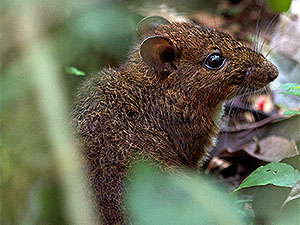
Red Forest Rat (Nesomys rufus)
Photo: Brian Gratwicke
https://creativecommons.org/licenses/by/2.0/
*********************
edited: 14.05.2022
Dypsis ambanjae Beentje
Ambanja Dypsis Palm (Dypsis ambanjae)
The Ambanja Dypsis Palm was described in 1933, the species was endemic to the Ambanja District in northern Madagascar.
The species has never been recorded since its description and is thus believed to be extinct.
*********************
edited: 06.05.2019
Coua delalandei (Temminck)
Delalande’s Coua; Snail-eating Coua (Coua delalandei)
The genus Coua consists of 11 species including severeal subspecies. All of them without exception live in Madagascar. The German name ‘Seidenkuckuck’ (silk cuckoo) relates to their plumage, which indeed shows a very fine, silky gloss.
Delalande’s Coua, with a full length of about 60 cm, was the largest member of its genus surviving into historical times. It lived in the dense rain forests of the island of Nosy Boraha (Île Saint Marie) offshore Madagascar’s northeast coast.
Unfortunately there is not much known about the live of this species. It is known however, that it stayed on the forest floor most of the time and that its preffered food were snails. Actually the Malagasy name ‘Famakisifotra’ translated into English means something like ‘snail crusher’.
The main reason for the extinction of this species is supposed to have been the hunting by the native people, who caught the birds mainly because of their beuatiful feathers.
The last sighting of this beautiful species happened in the year 1834.
*********************
References:
[1] Dieter Luther: Die ausgestorbenen Vögel der Welt. Westarp Wissenschaften 1986
[2] Errol Fuller: Extinct Birds. Penguin Books (England) 1987
*********************
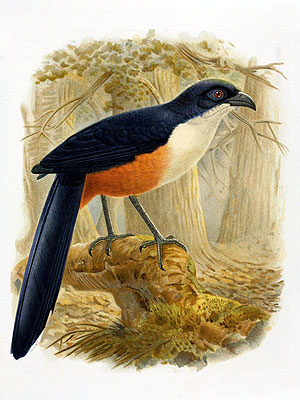
(public domain)
*********************
edited: 27.11.2018
Coua berthae Goodman & Ravoavy
Berthe’s Coua (Coua berthae)
This species is known from subfossil remains dating to an Holocene age and was described in 1993.
Berthe’s Coua was the largest member of its genus, it may have reached a size of about 80 cm, making it 25% larger than the recent Giant Coua (Coua gigas (Boddaert)) (see photo), which is the largest living member of its genus today.
The species was very likely a bad flyer and may indeed have largely been restricted tot he forest floor, where it was an easy victim to early human hunters.
*********************
References:
[1] Steven M. Goodman; Florent Ravoavy: Identification of bird subfossils from cave surface deposits at Anjohibe, Madagascar, with a description of a new giant Coua (Cuculidae: Couinae). Proceedings of the Biological Society of Washington 106(1): 24-33. 1993
*********************

Photo: Dick Daniels
http://carolinabirds.org
(under creative commons license (3.0))
http://creativecommons.org/licenses/by-sa/3.0
*********************
edited: 27.11.2018
Euphorbia alcicornis Baker
Elk-horned Spurge (Euphorbia alcicornis)
The Elk-horned Spurge, described in 1887, is, or was, restricted to central Madagascar.
It is a succulent, multi-branched shrub or treelet, its upright growing branches are about 0,3 to 0,5 cm in diameter.
***
The Elk-horned Spurge is not fully researched and might turn out to be not a valid species at all.
*********************
edited: 18.01.2020
Hippopotamus laloumena Faure & Guérin
Laloumena Hippopotamus (Hippopotamus laloumena)
The Laloumena Hippopotamus was described in 1990, it is the largest of the three known Malagasy Hippopotamus species, reaching almost the size of an African Hippopotamus (Hippopotamus amphibius L.).
This species is known from Pleistocene deposits that can be dated to an age of around 20000 years before present, but also from much younger remains that clearly are of Holocene age. [1][2]
***
It is quite possible that this species begun to disappear due to changes in the climatical conditions of Madagascar, leading to a drier climate, but it was very likely finally wiped out by humans.
*********************
References:
[1] M. Faure; C. Guérin: Hippopotamus laloumena nov. sp., la troisième espèce d’hippopotame holocène de Madagascar. Comptes Rendus de l’Académie des Sciences. Ser. II 310: 1299-1305. 1990
[2] Martine Faure; Claude Guérin; Dominique Genty; Dominique Gommery; Beby Ramanivosoa: Le plus ancien hippopotame fossile (Hippopotamus laloumena) de Madagascar (Belobaka, Province de Mahajanga). Comptes Rendus Palevol 9(4): 155-162. 2010
*********************
edited: 16.05.2019
Monias sp. ‘Anjohibe’
Anjohibe Mesite (Monias sp.)
Today, the Subdesert Mesite (Monias benschi Oustalet & Grandidier) (see picture below) is the only member of its genus, it is restricted to a small lowland region in southwest Madagascar.
However, once there existed at least one additional species, this one is known from subfossil remains that were recovered from Holocene deposits from the Anjohibe Cave near the northwestern coast of Madagascar.
The species has not yet been described, and I personally have no further information about it. [1]
*********************
References:
[1] Steven M. Goodman, William L. Jungers: Extinct Madagascar: Picturing the Island’s Past. The University of Chicago Press 2014
*********************

Depiction from: ‘Alfred Grandidier: Histoire Physique, Naturelle et Politique de Madagascar. Paris: à l’Imprimerie Nationale 1836-1921’
(public domain)
*********************
edited: 22.05.2019
Euphorbia tardieuana Leandri
Tardieu’s Spurge (Euphorbia tardieuana)
This species is known exclusively from the type collection made in 1927 in the evergreen forests in the area around the two rivers Mangoro and Nosivolo at Madagascar’s east coast.
The species appears to have never been found since, and since the type locality is now highly degraded, it may be completely extinct.
***
There exists the chance that Tardieu’s Spurge is identical with another spurge species, Mangelsdorff’s Spurge (Euphorbia mangelsdorffii Rauh.), a species that is quite well known and often kept in cultivation.
*********************
edited: 13.05.2013
Voay robustus (Grandidier & Vaillant)
Madagascar Crocodile (Voay robustus)
The Madagascar Crocodile was described in 1872, it is known only from subfossil remains, that were found very numerously on the island of Madagascar.
The species reached lengths of about 5 m.
***
Madagascar is now inhabited by another crocodile species, the Nile Crocodile (Crocodylus niloticus (Laurenti)), which might have occurred sympatrically with the extinct species, or which – more likely – was only able to successfully establish itself after the extinction of the endmic species.
*********************
edited: 04.10.2020
Bulbophyllum sanguineum H. Perrier
Blood-red Bulbophyllum Orchid (Bulbophyllum sanguineum)
The Blood-red Bulbophyllum Orchid was described in 1937, it is endemic to Madagascar, where it grows, or was growing, as a small epiphyt in the forests at higher elevations.
The species was apparently never found since its description and, given the fact that most of Madagascars forests still are burned down, this species may now quite well be extinct.
***
The species is obviously sometimes mistaken for another one, the Red-puncted Bulbophyllum Orchid (Bulbophyllum sanguineopunctatum Seidenf. & A. D. Kerr), which is quite commonly found in cultivation.
*********************
edited: 12.11.2020
Aepyornis hildebrandti Burckhardt
Hildebrandt’s Elephant Bird (Aepyornis hildebrandti)
Hildebrandt’s Elephant bird was described in 1893 based on subfossil bones, several forms originally described as distinct are now included in this species as synonyms, the material of one of them, Aepyornis mulleri Milne-Edwards & Grandidier, however, is now lost.
The species was somewhat smaller than the Large Elephant Bird (Aepyornis maximus Geoffroy Saint-Hilaire).
Hildebrandt’s Elephant bird is one of only two species within its genus that still are accepted after a revision in 2018. [1]
*********************
source:
[1] James P. Hansford; Samuel T. Turvey: Unexpected diversity within the extinct elephant birds (Aves: Aepyornithidae) and a new identity fort he world’s largest birds. Royal Society Open Science, 2018; 5(9): 181295 DOI: 10.1098/rsos.181295
*********************
edited:
27.09.2018
Vanellus madagascariensis Goodman
Madagascar Lapwing (Vanellus madagascariensis)
This species is known only from subfossil remains that were found in southwest Madagascar.
The remains were dated to an age of about 600 years, thus the species survived at least into the 14th century, it may have died out because of a aridification of its habitat, which may have happened in a natural way or due to human interference.
*********************
edited: 04.10.2020
Hipposideros besaoka Samonds
The Besoaka Roundleaf Bat was described in 2007 based on subfossil remains that were recovered from deposits in the Grotte d’Anjohibe in the former Mahajanga Province in northern Madagascar.
The species was closely related to the recent Commerson’s Raoundleaf Bat (Hipposideros commersoni (E. Geoffroyi)) (see photo below) and both species apparently lived sympatrically.
The Besoaka Roundleaf Bat seems to have disappeared at the beginning of the Holocene.
*********************
References:
[1] K. E. Samonds: Late Pleistocene bat fossils from Anjohibe Cave, northwestern Madagascar. Acta Chiropterologica 9(1):39–65. 2007
*********************
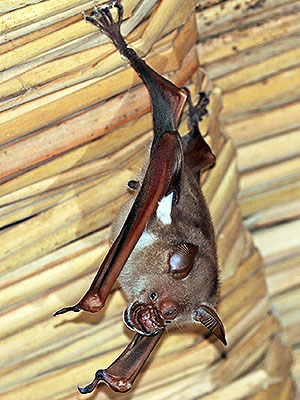
Commerson’s Roundleaf Bat (Hipposideros commersoni)
Photo: Charles J. Sharp
https://creativecommons.org/licenses/by-sa/4.0/
*********************
edited: 17.05.2022
Centrornis majori Andrews
Madagascar Sheldgoose (Centrornis majori)
The Madagascar Sheldgoose was a large goose that once inhabited Madagascar, it was described on the basis of fossil bones that are dated to a Late Pleistocene age, however, it is quite sure that this species survived into the early Holocene, thus it is mentioned here.
*********************
edited: 01.11.2020
Tropodiaptomus ctenopus Kiefer
Comb-footed Pelagic Copepod (Tropodiaptomus ctenopus)
This species was described in 1930 from the region of Antananarivo, Madagascar.
The Comb-footed Pelagic Copepod, whose biology is completely unknown, was never found again and is believed to be extinct.
***
Another species, the Malagasy Pelagic Copepod (Tropodiaptomus madagascariensis (Rylov)), is a planktonic species that appears to be endemic to some of the lakes at the Central Highlands region.
*********************
edited: 07.11.2017
Dypsis canescens (Jum. & H. Perrier) Beentje & J. Dransf.
Grey Dypsis Palm (Dypsis canescens)
The Grey Dypsis Palm was described in 1913, it was endemic to the islnd of Madagascar.
The species has apparently never been found since and is considered mostblikely extinct.
*********************
edited: 06.05.2019
Archaeolemur majori Filhol
The Monkey Lemur was described in 1895 based on subfossil remains that were found on the island of Madagascar.
*********************
edited: 01.08.2022
Archaeolemur edwardsi Filhol
Edward’s Monkey Lemur was described in 1895 based on subfossil bones that were found on the island of Madagascar.
*********************
edited: 01.08.2022
Coua primaeva Milne-Edwards & A. Grandidier
Ancient Coua (Coua primaeva)
The Ancient Coua was described in 1895 from subfossil remains.
When alive, this species was the second largest of its genus, reaching a length of over 70 cm.
The species disappeared at a time of about 2000 to 600 years ago.
*********************
edited: 27.11.2018
Hovacrex roberti (Andrews)
Hova Gallinule (Hovacrex roberti)
The Hova Gallinule was described in 1897 based on subfossil remains found on the island of Madagascar.
The species was quite large, perhaps about 50 cm.
The known remains only include the pelvis and the hind limbs, thus it is not known if this species was flightless.
*********************
edited: 04.05.2019
Coua cristata ssp. maxima Milon
Large Crested Coua (Coua cristata ssp. maxima)
The Crested Coua (Coua cristata (L.)) is one of the about 11 species of its genus that are endemic to the island of Madagascar. It reaches a size of about 40 cm and is split into three subspecies, of which one appears to be extinct.
***
The Large Crested Coua was described in 1950 based on a single specimen that was collected near the city of Tôlanaro (formerly Fort Dauphin) in the Toliara Province, southeast Madagascar.
The subspecies differed from the other two by its much larger size.
This somewhat enigmatic form was never seen again and is considered extinct.
*********************
References:
[1] Pete Morris, Frank Hawkins: Birds of Madagascar, A Photographic Guide. Bloomsbury Specialist 1998
*********************

Depiction from: ‘Alfred Grandidier: Histoire Physique, Naturelle et Politique de Madagascar. Paris: à l’Imprimerie Nationale 1836-1921’
(public domain)
*********************
edited: 06.11.2017
Pseudoxyrhopus ankafinaensis Raxworthy & Nussbaum
Ankafina Ground Snake (Pseudoxyrhopus ankafinaensis)
Thie Ankafina Ground Snake was described in 1994, it is known exclusively from a single specimen that was collected in 1880 somewhere in Madagascar.
The species was never found again and is considered extinct.
*********************
edited: 24.04.2019
Euphorbia hexadenia Denis
Ambovatoby Spurge (Euphorbia hexadenia)
This species was described in 1887, originally as Euphorbia daphnoides Baill., however, this name was already used for another species, so the species was redescribed in 1921.
The species was apparently restricted to the Ambavatoby Bay at the north coast of Madagascar.
***
Unfortunately I could not found any more information about this species.
*********************
References:
[1] Thomas Haevermans; Germinal Rouhan; Wilbert Hetterscheid; Marc Teissier; Karim Belarbi; Xavier Aubriot; Jean-Noël Labat: Chaos revisited: nomenclature and typi fi cation of the Malagasy endemic Euphorbia subgenus Lacanthis (Raf.) M. G. Gilbert. Adansonia sér 3. 31(2): 279-299. 2009
*********************
edited: 23.04.2019
Bulbophyllum erythroglossum Bosser
The Red-tongued Bulbophyllum Orchid was described in 2000, apparently when it already wasn’t existing anymore.
The species was found in the vicinity of the city of Toamasina in the Atsinanana Region of eastern Madagascar, it was last recorded in 1964 but hasn’t been found since and is thus very likely extinct.
*********************
edited: 23.04.2022
Tachybaptus rufolavatus (Delacour)
Alaotra Grebe (Tachybaptus rufolavatus)
This Alaotra Grebe was endemic to lake Alaotra, and surrounding lakes in northern central Madagascar.
The species declined during the 20th century due to habitat desctruction and the introduction of the notoriously predatory Blotched Snakehead (Channa maculata Lacépède), a fish that devoures any animal of suitable size, bird or mammal, that dares to enter the water.
The last remaining birds also hybridized with Little Grebes (Tachybaptus ruficollis ssp. capensis (Salvadori)), that are native to Madagascar and shared their habitat with this species.
The last Alaotra Grebe was found and photographed in 1985, the only existing photograph of a living individual (which, however, may already have been a hybrid bird).
*********************
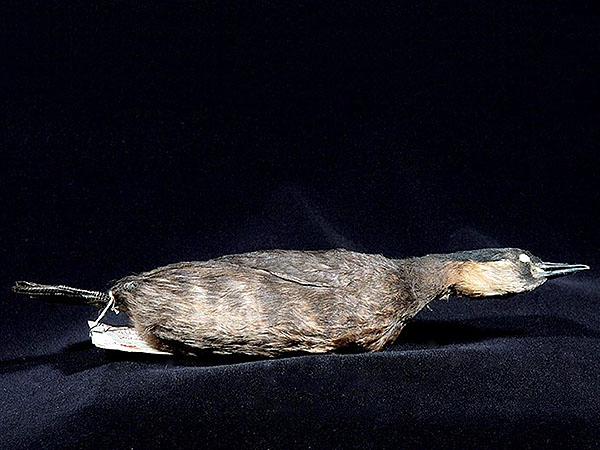
(under creative commons license (3.0))
http://creativecommons.org/licenses/by-sa/3.0
*********************
edited: 27.11.2018
Corythornis madagascariensis ssp. dilutus Benson
Sakaraha Pygmy Kingfisher (Corythornis madagascariensis ssp. dilutus)
The Madagascar Pygmy Kingfisher, locally known as Tsakoko manga, is a 12 to 13 cm large, typical kingfisher species that inhabits large parts of Madagascar.
***
The form discussed here is known from only a single specimen which was collected around 1970 in the Zombotse Forest near the city of Sakaraha in the Sakaraha District, Toliary Province in the arid southwest of Madagascar, and which differs somewhat from the ‚common form‘, and which thus was described as a distinct subspecies.
The Sakaraha Pygmy Kingfisher is now considered extinct, because no additional specimen could ever be located.
*********************
References:
[1] Pete Morris, Frank Hawkins: Birds of Madagascar, A Photographic Guide. Yale University Press 1998 [2] C. Hilary Fry, Kathie Fry, Alan Harris: Kingfishers Bee-eaters & Rollers. A & C Black 1999
*********************

Depiction from: ‘Alfred Grandidier: Histoire Physique, Naturelle et Politique de Madagascar. Paris: à l’Imprimerie Nationale 1836-1921’
(public domain)
*********************
edited: 24.03.2017
